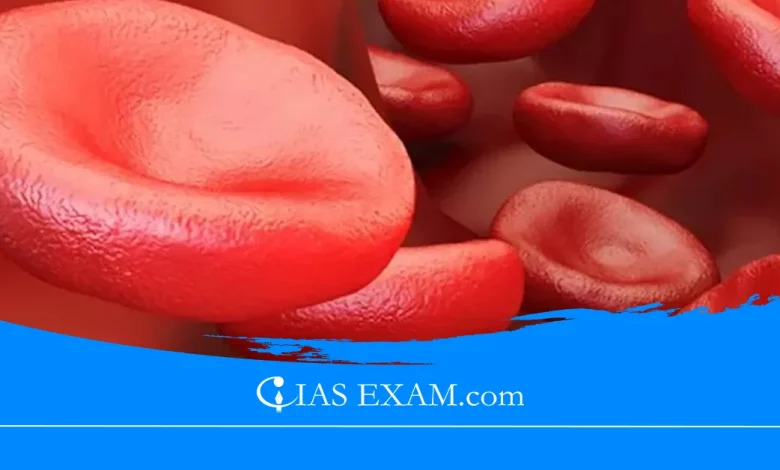Daily Current Affairs for UPSC
Sickle Cell Disease Treatment Challenges: Inaccessibility and Cost
Syllabus: Science & Technology, [GS Paper - 3]

Context
Recently, the story of five-year-old Suraj’s trip from Nuapada District Hospital to the Veer Surendra Sai Institute of Medical Sciences highlights the challenges that marginalised communities face when trying to get healthcare. Sickle Cell Disease, which is common among tribal populations, needs immediate attention.
About Sickle Cell Disease
- Sickle cell disease is a genetic disorder where haemoglobin (a protein that carries oxygen in the blood), which is abnormal, is responsible for the cells to take the shape of a “sickle” and become hard. It may have an effect on rerouting the system and may cause the inflow of blood to be interrupted and hence, this may result in clots, pain, organ damage, and more maladies.
- The disease known as sickle cell disease is carried from generation to generation by an autosomal recessive inheritance which only comes about because of two parents having to pass on abnormal haemoglobin genes to the child. For an autosomal recessive disorder, if one individual carries only one mutant gene, they are called a carrier of Sickle Cell Trait. They are usually asymptomatic.
- In sickle cell disease, there is a lot of variation in the level of severity of the disease symptom. Some individuals might suffer severe and frequent complications, while others may not manifest the disease symptoms for some time or even for the whole of their lifetime.
- SSC often leads into vaso-occlusive crises that are very-evaluated by blocking blood flow, presenting with tissue damage. Furthermore, it increases risk of anaemia, infections, stroke, acute chest syndrome, and harm to organs such as liver, kidneys, spleen and lungs.
- It is more common among populations that had their ancestry from the regions with high malaria prevalence, in other words, Sub-Saharan Africa, the Middle East, India and their surrounding region. The gene alteration to aether syndrome served as an agent against a disease like malaria, this led to a higher rate of the occurrence of the syndrome in the areas.
- Primary aims of sickle cell disease treatment are to prevent complications or address the symptoms and allow a person to have the good quality of life. Per this, the use of medicines for pain relief, infection prevention, and reducing the risk of stroke are some applicable examples. Sometimes, a patient can receive transfusions of packed RBCs, erythrocytapheresis therapy, or even bone marrow transplantation.
- In order to detect sickle cell disease early on, the use of newborn screening to find people with the carrier status of the disease is necessary as well as the provision of genetic counselling. Let us also make it a top priority to create a supportive system that avails education, support and comprehensive healthcare services to people with sickle cell disease. These are important for the enhancement of their wellbeing and improvement of outcomes.
Challenges in treatment
- On the treatment of this rare case of Sickle Cell Disease, there are uncertainties facing every patient.
- Healthcare is limited especially in the wilderness areas, and this is the biggest problem for issues at hand, such as delayed diagnosis and marginal treatment.
- The high price for treating sickle cell disease can imply tremendous financial difficulties for patients, particularly in aspects where the use of the cover is restricted.
- Healthcare specialists, as well as professionals in the social field, have the problem of insufficient knowledge, which leads to the late diagnosis, and inadequate support for the patients.
- Available treatment methods for this condition are not that much successful and there is a lot of need for more efficient therapies. Nevertheless, limited funds and the intricacy of the disease are impediments for those looking into more effective therapy.
- Cases of Sickle Cell Disease are sometimes accompanied by stigma, depression, and low quality of life, which underline the vital need for comprehensive treatment of this disease.
- To eliminate these challenges parties must cooperate and improve health care access, reduce the cost of medication, increase people’s awareness, make research available and give patients and their caregivers psychological support.
Conclusion and Way Forward
- The plan to improve the scenario is, to form a comprehensive treatment system, which will integrate core medical care based on biomedical care and psychological counselling, so the problem is alleviated and the frail people’s quality of life is improved such as Suraj.
- Multidirectional path is appreciated because it aids in hindering the nature of those disasters that occur because of serious inequality towards health.
Source: The Hindu
UPSC Mains Practice Question
Q.Discuss the challenges faced in treating Sickle Cell Disease (SCD) and propose strategies to address them. How can collaborative efforts between healthcare providers, researchers, policymakers, and community stakeholders facilitate effective management of SCD?





.png)



